Compartimos las participaciones de miembros de los distintos grupos de investigación de INBIOTEC en Congresos, Jornadas y Reuniones científicas.
9 al 10 de julio de 2021
Nitric oxide synthase, Arginine and NO: are they involved in responses to nitrogen deficiency in Ostreococcus tauri?
Noelia Foresi, Gonzalo Calo, Fiorella Del Castello, Andres Nejamkin, Giselle Martínez-Noël, Graciela Salerno, Lorenzo Lamattina, Natalia Correa-Aragunde.
Resumen:
The results provide evidence that NO has a role in N-deficiency response in O. tauri and that L-Arg may overcome the lack of this nutrient. The role of enzymes involved in Arg degradation and the putative action of NOS-derived NO within cell N metabolism will be discussed.

Viernes 17 de septiembre de 2021
Cápsulas de alginato para la formulación de bacterias entomopatógenas aplicadas al control de mosquitos de importancia sanitaria
https://www.jobion.com.ar/3ra-jobion-2021

15 al 17 septiembre de 2021
Actividad y abundancia de hongos micorrícicos y bacterias en suelos andinos del Altiplano Jujeño bajo cultivo con manejo sustentable
Fernanda Covacevich, Darío C. Castro, Keren Hernández Guijarro

Resumen:
El objetivo de este trabajo fue determinar el impacto de diversos manejos de producción en La Puna jujeña sobre la colonización de raíces por hongos formadores de micorrizas arbusculares (habitantes nativos del suelo y reconocidos promotores de crecimiento vegetal y con roles en la conservación del suelo) y la abundancia de bacterias totales. Para ello se colectaron muestras durante dos años en dos suelos agrícolas en rotación (papa/quinoa y quinoa/triticale), un suelo debajo del guano compostado de llama, todos con riego por goteo y fertilización química; además de un suelo prístino. En general la mayor colonización de raíces se registró en el suelo prístino y en el que recibió guano, y la menor en los agrícolas. La abundancia de bacterias totales cuantificada a través del gen ARN ribosomal 16S de Eubacterias mediante PCR cuantitativa varió en los años de estudio en relación al manejo del sistema, no pudiéndose establecer un patrón claro. El próximo paso es cuantificar poblaciones bacterianas que cumplan roles claves en la productividad de los sistemas.
13 al 17 de septiembre de 2021
Dynamics of proline accumulation under salt stress is affected by the conserved kinase SnRK1 in Aarbidopsis thaliana
Giuliano Barbieri, Rodrigo Parola, Giselle M. A. Martínez-Noël, Marianela Rodriguez
Resumen:
All data suggest that SnRK1 is involved in the dynamics of proline accumulation under salt stress, possibly through the increase of the catabolism at short-term stress and later in the metabolite accumulation.
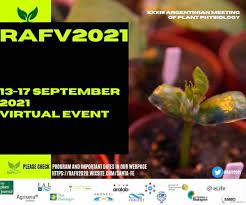
13 al 17 de septiembre de 2021
Irradiance affects sugar distribution and storage in the sunflower plant
Leonela A. Garcia, Giselle M.A. Martínez Noël, M. Eugenia Giorgi, Jorge A. Tognetti, Guillermo A. A. Dosio
Resumen:
Our results suggest that sunflower has a high morphological plasticity to changes in radiation, which may strongly affect plant capacity to deliver reserves to grains, while maintaining relatively constant stem sugar concentrations.

22 y 23 de septiembre de 2021
Estudio de Interacción fusarium poae-brachypodium distachyon
Dinolfo, M.I., Martínez, M., Castañares, E., Arata, A.F., Arroyo F., Rodríguez, C., Stenglein, S.A
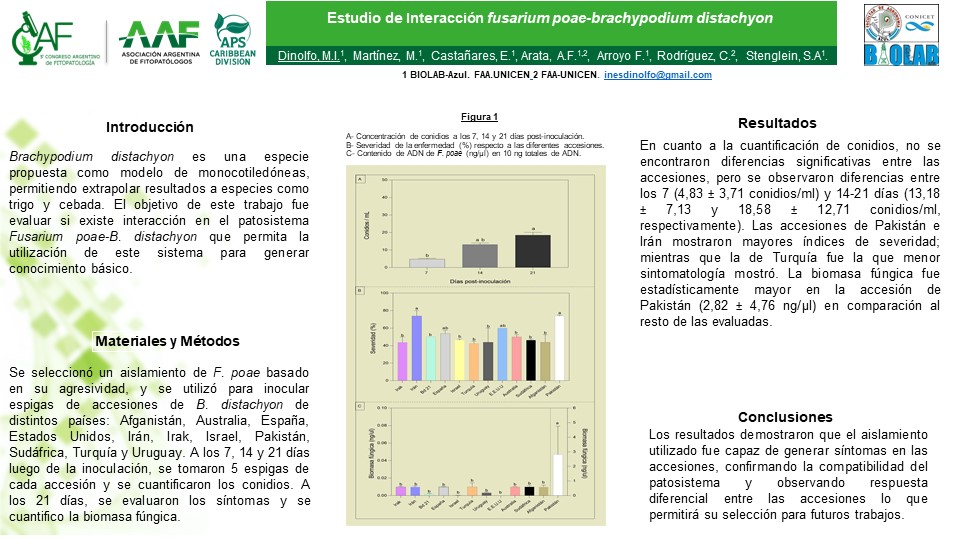
22 y 23 de septiembre de 2021
Variaciones en la composición fúngica de granos de maíz (zea mays) almacenados en silo bolsa dependiendo del momento de ensilado, la duración del almacenamiento y el híbrido
Martínez, M., Castellari, C, Arata, A.F., Fernández, D. Dinolfo, M.I.
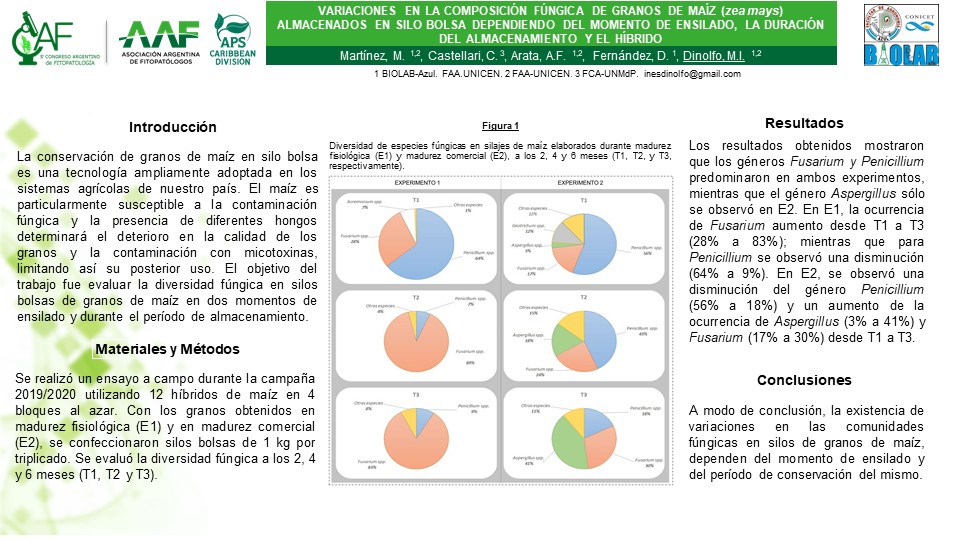
29 y 30 de septiembre de 2021
Nitrógeno mineralizado en anaerobiosis en macroagregados como indicador de la nutrición de trigo
García,GV; Reussi Calvo,NI; Wyngaard,N; San Martino, S; Fernanda Covacevich, Studdert, GA
Resumen:
Se estudió la abundancia y diversidad de hongos formadores de micorrizas arbusculares, habitantes nativos del suelo y reconocidos promotores de crecimiento vegetal y con roles en la conservación del suelo. Los estudios se realizaron en tres sitios agrícolas de la Pampa Argentina. Se detectó mayor abundancia y diversidad de los hongos estudiados en sistemas que incluyen manejos sustentables del cultivo de soja (cuyo objetivo es mantener el suelo con cobertura vegetal la mayor parte del año), tales como sistemas con inclusión de cultivos de cobertura antes de la soja, o soja en rotación con otros cultivos, en relación al monocultivo de soja (en el que el suelo se encuentra desnudo gran parte del año). Se destaca la importancia de implementar sistemas de manejo más conservacionistas a los de utilización actual para la producción de soja, de manera de favorecer la microbiota nativa que cumple roles de importancia en la salud del suelo y producción vegetal.
6 y 7 de octubre de 2021
Cianobacterias: Nuevas Plataformas Sostenibles de Aplicación en el Diseño de Indicadores de Frescura de Alimentos
Sanchez Rizza Lara, Curatti Leonardo, Martucci, Josefa, Ruseckaite, Roxana

4 al 8 Octubre de 2021
Effect of agricultural systems with soybean predominance on mycorrhizal fungi native to contrasting soils of the Pampean region (Argentina)
Commatteo, JG; Cabello, MN; Barbieri, PA; Fernanda Covacevich
Resumen:
Se estudió la abundancia y diversidad de hongos formadores de micorrizas arbusculares, habitantes nativos del suelo y reconocidos promotores de crecimiento vegetal y con roles en la conservación del suelo. Los estudios se realizaron en tres sitios agrícolas de la Pampa Argentina. Se detectó mayor abundancia y diversidad de los hongos estudiados en sistemas que incluyen manejos sustentables del cultivo de soja (cuyo objetivo es mantener el suelo con cobertura vegetal la mayor parte del año), tales como sistemas con inclusión de cultivos de cobertura antes de la soja, o soja en rotación con otros cultivos, en relación al monocultivo de soja (en el que el suelo se encuentra desnudo gran parte del año). Se destaca la importancia de implementar sistemas de manejo más conservacionistas a los de utilización actual para la producción de soja, de manera de favorecer la microbiota nativa que cumple roles de importancia en la salud del suelo y producción vegetal.

4 al 8 Octubre de 2021
Optimización del método de extracción y cuantificación de proteínas del suelo relacionadas con la glomalina extraídas de sistemas con predominio de soja
Commatteo, JG; Barbieri, PA, Fernanda Covacevich
Resumen:
Se optimizó el método estándar de extracción de glomalina, una glicoproteína del suelo, secretada por los hongos micorrícicos arbusculares habitantes nativos del suelo y reconocidos promotores de crecimiento vegetal y con roles en la conservación del suelo. La importancia de la detección y cuantificación de la glomalina se basa en que se une a las partículas del suelo otorgándole mejoras en su estabilidad, por lo que se la reconoce como un indicador de la actividad de estos hongos y de la calidad del suelo. El método de extracción de glomalina optimizado mejoró la precisión de la extracción-cuantificación y redujo considerablemente el tiempo del proceso. El método optimizado mostró ser mas sensible en detectar cambios en las prácticas del manejo del suelo hacia manejos mas sostenible en relación al método estandar.
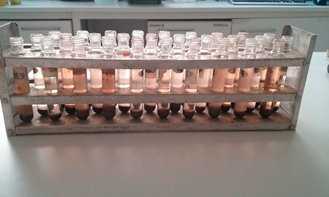
21 al 23 de Octubre de 2021
TOR signaling in the smallest free-living photosynthetic eukaryote to Target of rapamycin (TOR) signaling in photosynthetic organisms
G CALÓ, A DE MARCO, GL SALERNO AND GMA MARTÍNEZ-NOËL
Resumen:
Taken together, our data indicate that TOR signaling is conserved in the plant lineage and in Ostreococcus, showing some specific features. Thus, we propose this unicellular green alga as a good and simple model for studying TOR kinase and its regulation.
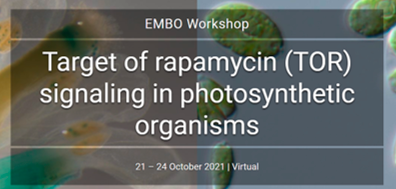
Links:
https://meetings.embo.org/event/21-tor
https://meetings.embo.org/event/21-tor#Programme
21 al 23 de Octubre de 2021
Effect of SnRK1 on dynamics of proline accumulation under salt stress in Arabidopsis thaliana
Giuliano Barbieri, Rodrigo Parola, Giselle M. A. Martínez-Noël, Marianela Rodriguez
Resumen:
SnRK1.1 is involved in the dynamics of proline accumulation under salt stress, playing a key role in the metabolite biosynthesis regulation in Arabidopsis.

Links:
https://meetings.embo.org/event/21-tor
https://meetings.embo.org/event/21-tor#Programme
1 al 4 de noviembre
Volatile compounds-mediated plant growth modulation by Microbacterium sp. Strain 15III
Burgos Herrera G, Do Nascimento M, Curatti, L
The present study was conducted to advance in the characterization of the plant growth-promotion properties of a native strain of Microbacterium sp. strain 15III, isolated earlier from a microalgal non-axenic culture. We observed previously a dose-dependent modulation of wheat seeds germination and sprouts growth form promotion (lower dose) to strong inhibition (higher dose) by inoculation of Microbacterium cells. Inoculation of wheat seedlings with this bacterium promoted leaves and roots dry weigh, and leaves length and chlorophyll content. In this study, to evaluate whether growth promotion would be at least mediated by volatile compounds, we conducted similar experiments in which the Petri dishes also contained a smaller dish containing Microbacterium sp. at different densities onto LB medium. The results suggested that the previously observed wheat growth-promotion could be mediated by volatile compound released by the bacterium. To further analyze whether this effect could be a general effect on plant-growth modulation, similar experiments were conducted with Arabidopsis thaliana, as a plant distantly related to wheat, and also a convenient experimental model. In these experiments, Microbaterium sp. exerted a similar dose-dependent seedlings growth modulation from stimulation to strong inhibition at higher bacterial densities. Similar experiments using chambered Petri dishes to isolate plants from bacteria, showed a similar dose-dependent plant growth modulation. Asymmetric placement of seedlings and bacteria in the dishes also showed a gradual effect according to the relative distance between the seedlings and the bacterial inoculation spots. A. thaliana seedlings exposed to this bacterium’s volatile compounds showed a dose-dependent more branched root-architecture and a significant increase in the number of root hairs. A preliminary gas chromatography coupled to mass spectrometry (GC-MS) analysis revealed the identity of the most abundant volatile compounds as small nitro-sulfur compounds such as dimethyl trisulphide and imidazolthione, which are strong candidates to be involved in the plant-growth modulating properties of Microbacterium sp. strain 15III. After immersion of A. thaliana flowers with a suspension of Microbacterium cells, the bacterium was consistently recovered from surface disinfected seeds and remained cultivable. It appeared that immersion in a higher cell density produced higher bacterial titles in the disinfected seeds. These results suggest a possible facultative endophytic life-style, and tolerance to the dehydrating conditions during seed development.
1 al 4 de noviembre
Induced production of amylolytic cazymes of a native aspergillus niger strain using wheat bran and microalgal biomass as a hydrolyzable substrate
Bader AN, Sánchez Rizza L, Consolo VF, Curatti L
Microalgae can be considered as a source for the production of bioethanol given its great photosynthetic efficiency and productivity as well as the independence of fertile lands as an alternative energy source to fossil fuels. One of the challenges to maximize bioethanol production is to explore economic and practical alternatives to totally or partially replace the current biomass pretreatment processes such as physical-chemical hydrolysis, a process that, in addition to requiring a large amount of energy and generating polluting waste it can lead to the breakdown of fermentable sugars. Enzymatic hydrolysis methods are selective, simple to operate, and low in energy consumption, although they have a high cost. A promising option is the search for fungal secreting hydrolytic enzymes capable of efficiently degrading the starch molecules contained in the microalgal biomass. The aim of this study was to characterize the enzymatic secretion profiling from a native fungal strain of Aspergillus niger and optimize the enzymatic hydrolysis conditions against different microalgal biomasses. For fungal enzymatic induction, the native fungal strain IB-34 was grown in glucose potato agar medium at 25 °C for 7 d until sporulation.
A suspension of 1 x 106 conidia/ml was prepared to inoculate solid substrate based on wheat bran and biomass from the microalgae Scenedesmus obliquus and Chlorella sorokiniana. Cultures were incubated for 8 d and then the extraction of the enzymes was performed using NaAc buffer solution at pH 5. Determination of enzymatic activity after induction on C.
sorokiniana biomass reached 1389 ± 323 U / L, for wheat bran 1758 ± 360 and 1085 ± 553 for S. obliquus respectively. The protein profiles of each enzyme extracts were characterized in SDS-PAGE gels and in all samples amylolytic activity was strongly visualized by zymography using starch as substrate. Enzymatic saccharification tests were carried out on biomass of C. reinhardtii, C. sorokiniana and S. obliquus at 20% solid load for 24 h, reaching 53, 34 and 18 g / L of reducing sugars and hydrolysis efficiency of 60, 30 and 18% respectively. To identify the extracellular enzymes involved in the degradation of wheat bran medium the secretome of the culture supernatant of the fungus were analyzed by MS-MS mass spectrometry. As expected, it was found that the fungus secreted mainly alpha amylase and glucoamylase enzymes although other as cellobiohydrolases and xylanases were determined. These results suggest that the A. niger strain IB-34 is a good candidate for the saccharification and biorefinery of microalgae biomass, to achieve a more profitable biofuel production, using the concepts of circular economy.
1 al 4 de noviembre
Genetic engineering of ammonium release and competitive fitness in the n2-fixing bacterium Azotobacter vinelandii
Ambrosio R, Curatti L
Copious release of NH4 + was successfully accomplished by different genetic strategies largely surpassing those of the parental strains. However, most of the times this was accompanied by very slow growth, and frequent reversion into non-NH4 + - excreting phenotypes, which, in addition to severe regulation of genetically engineered bacteria for its use in field trials, obscures the prospects of developing further this kind of N-biofertilizers. Here we analyzed the bacterial population dynamics of a set of ammonium-excreting A. vinelandii strains in long term laboratory experiments regarding their competitive fitness in comparison with their parental strain (wt) and the genetic stability of the mutations. NH4 + - excreting strains bearing a deletion in nifL for constitutive expression of the N2 fixation genes, a point mutation on glnA (D49S) for decreased activity of glutamine synthetase (GS) and impaired conversion of NH4 + into amino acids, or both, were rapidly excluded by competition with the wt strain in long-term co-culture experiments. Conversely, other strains expressing only an inducible allele of glnA, or in combination with the nifL mutation, initially displayed an increased competitive fitness in comparison with the wt strain, reducing its population up to 1,000-fold. These strains allowed the accumulation of different levels of GS, which become depleted by cell-division in non-inducing medium. Under these conditions, the mutant strains displayed a dynamic competitive fitness in comparison with the wt strain according to the previous strength of induction of glnA. At even longer times, the wt strain took over and returned to the initial relative levels and begun outcompeting the mutant strains. These genetically engineered bacteria revealed a self-bio-containment behavior which could eventually be improved and considered for their safe release into the environment. All the strains analyzed reverted into faster growing and non-NH4 - -excreting clones in 16- 20 bacterial cell generations under regular conditions for A. vinelandii culture under laboratory conditions. However, preliminary experiments in which the mutant strains with the inducible allele of glnA were inoculated into sterile soil increased the NH4 + content of the soil and allowed the isolation at a high frequency of clonal strains conserving the characteristic mutant phenotype after two months of inoculation, suggesting a greater genetic stability under these conditions. These results encourage further research of the genetic engineering strategy used in this study to improve A. vinelandii and/or any other robust plant growth-promoting bacteria to align fertilization efficiency and environmentally safe use.
1 al 4 de noviembre
Inoculation with Azospirillum strains overproducing auxin improves biomass and lipids productivity of a microalga under salt stress
Pagnussat L, Gonorazky G, Do Nascimieto M, Maroniche G, Creus C, Curatti L
There is currently an increasing interest in the use of microalgae for wastewater treatment and the use of its biomass and lipids as a feedstock for biofuels. Both of these applications are often performed more efficiently by microalgal-bacteria consortia. However, the mechanisms that account for the stability and robustness of this kind of interactions are poorly understood While salinity stress is a mild trigger of lipids accumulation in some microalgae, an increased lipids productivity is mostly offset by the slower growth. Nitrogen starvation is a much stronger trigger of lipids accumulation, but decreases biomass and lipids productivity to a more pronounced level than salt. Previously we showed that the plant growth-promoting bacterium Azospirillum baldaniorum Sp245 also promoted growth of the microalga Scenedesmus obliquus C1S. This alga-bacterium interaction depended on bacterial production of indole-3 acetic acid (IAA), which resulted in a decrease in reactive oxygen species of the algal cells and higher cell densities. S. obliquus showed a clear dose-dependent slow-down of growth and biomass productivity according to the NaCl concentration in the growth medium, in the range 0-225 mM, larger cell sizes are observed and the number of isolated microalgae cells is increased. Additionally, a reduction in the yield of microalgal biomass is observed. For further analysis, NaCl was used al 150 mM as a concentration which reduced algal growth in axenic cultures by 4-fold, but could be partially reverted in preliminary experiments of inoculation with some Azospirillum strains. Because we showed before that nitrogen starvation ameliorates the tolerance response to NaCl of some microalgae, we kept nitrogen sufficiency at 10 mM NaNO3 throughout the study. At this concentration of N, S. obliquus does not normally accumulate lipids. Under these experimental conditions, inoculation with IAA-overproducing bacterial strains, produce higher yields of biomass and neutral lipids than treatments with the wild type A. baldaniorum parental strain. Notably, preliminary results show that inoculation with these strains increased lipids accumulation at 30,79% (w/w). Conversely, inoculation with a bacterial strain impaired in the production of IAA failed to enhance algal biomass and lipids productivity under salt stress conditions. In this case lipids accumulation remained lower at 25,6 % (w/w). The fact that the four A. baldaniorum strains used in this study showed an almost identical survival rate under the stated co-culture conditions, led us to propose a prominent role of IAA in mediating the increase in algal biomass and lipids productivity exerted by A. baldaniorum under salt-stress conditions. This study extends the current knowledge of the mechanisms underlying bacteria-microalgae consortia to improve their technological applications and to better understand ecological relationships in the environment.
1 al 4 de noviembre
Regulated cell death in cyanobacteria: new horizons for developing methodologies to face the problem of cyanobacterial blooms
Cyanobacteria are ancient photosynthetic prokaryotes globally widespread, synthesize potent toxins and proliferate massively, forming blooms. Cyanobacterial blooms represent a major ecological and human health problem worldwide. The conditions that promote massive bloom proliferation have been extensively studied but in contrast, mechanisms causing their abrupt termination are poorly understood. Cell death plays a vital role in the dynamics of ephemeral blooms and critically determines the flow and fate of organic matter and nutrients. In recent decades, regulated cell death (RCD) induced by biotic or abiotic stresses stands as a major mechanism to explain the disappearance of blooms. Nonetheless, knowledge of the molecular basis and physiological mechanisms behind RCD in Cyanobacteria is very limited. The present work describes recent advances in regulated cell death in Synechocystis sp. PCC6803. Research conducted in our lab has led to the identification of a new cell death program in response to heat stress with biochemical and morphological features resembling eukaryotic ferroptosis. Canonical ferroptosis inhibitors and Calcium (Ca2+) prevent this cell death pathway. Moreover, this cell death process is dependent on iron availability and lipid peroxidation. Besides, cyanobacterial ferroptosis is characterized by depletion of glutathione (GSH) and ascorbic acid (AsA), and can be prevented by GSH or AsA addition. This is the first report of ferroptosis in a prokaryotic organism. Therefore, these results suggest that ferroptosis is an ancient cell death program conserved in eukaryotic and some prokaryotic organisms. Importantly, this work contributes to increasing our mechanistic understanding of how cyanobacteria cope with environmental stress and activate RCD and opens new applications in biotechnology, for instance, the development of new technologies to control harmful blooms and ensuring water quality, and preserving the health of the population. Finally, I will introduce the Green Cell Death Network, an international research consortium formed by early-career researchers investigating cell death in photosynthetic organisms.
